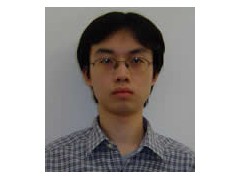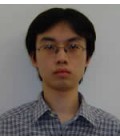卢文联,现任复旦大学数学科学学院副研究员, 复旦大学计算系统生物研究中心教授、博士生导师。主要研究方向包括:复杂系统与复杂网络理论和应用,神经网络模型的数学方法及其应用,非线性动力系统,信号处理。
教育及工作经历:
2012-2014年作为“玛丽-居里”学者在英国华威大学计算机系合作研究。
2005-2007 德国马克斯普朗克科学数学研究所,博士后。
2000-2005 复旦大学数学研究所 ,获应用数学专业 博士学位。
1996-2000 复旦大学数学系,获学士学位。
学术兼职:
1、 IEEE高级会员。
2、 2013年至今,IEEE Transactions on Neural Networks and Learning Systems副编辑。
3、 2010年至今,Neurocomputing的副编辑。
主要研究方向:
在应用数学、信号处理和计算机科学有浓厚的兴趣,包括: 神经网络模型的数学方法及其应用;计算神经科学的模型与方法;复杂系统与复杂网络理论和应用;非线性动力系统。
最新进展
时滞诱发的同步周期轨道
此研究工作显示,在多主体网络系统中,由于通讯时滞的存在,一致性协议可能不能收敛到平衡点,而是同步到一个周期轨道,此轨道的周期依赖于时滞的模式。此结果不仅对静态网络扑成立,对于一般的随机切换的网络结构也成立。
科研成果:
(1)具有不连续右端的神经网络的稳定性分析。首次证明了一类关于具有非光滑代价函数的神经网络系统的收敛性和关于具有不连续激发函数神经网络概周期解的存在性和稳定性。
(2).拓扑结构随时间变化,特别是具有随机性的复杂网络的协调性行为。我们提出的随机动力系统横向稳定性的研究方法,在理论和应用两层面都有一定的推动。
(3).高斯神经场模型的建立。在传统神经场模型基础上,利用计算神经元模型,结合实验数据,建立能刻画神经信号随机性的神经网络模型(矩神经场)。将神经放电序列(Spike Train)看作随机点过程。建立发展方程模型描述其一阶(平均激发率)和二阶统计量(神经放电时间间隔(ISI)的变差系数(CV)和放电序列的相关系数)时空分布,通过建立输入输出脉冲点过程的方差和相关系数,以及平均激发率的映射,从而用高斯随机场来描述神经脉冲的动力学行为。以此基础,建立新的前馈神经网络模型和递归神经网络模型。
共发表论文100余篇,其中SCI(SCIE)期刊论文42篇,第一作/通讯作者30篇。另在Springer-Verlag系列图书Complex Time-Delay Systems, Understanding Complex Systems中,受邀与他人合作撰写一章。据 Web of Science统计,所有的文章他引超过1500次。 。
代表性论文:
2016
1. Centralized and decentralized global outer-synchronization of asymmetric recurrent time-varying neural network by data-sampling.Lu W, Zheng R, Chen T. Neural Networks (2016).
2015
2. A statistical approach for detecting common features.Gan X, Xu B ,Ji X, Lu W, Waxman D, Feng J.Journal of Neuroscience Methods (2015).
3. Achieving cluster consensus in continuous-time networks of multi-agents with inter-cluster non-identical inputs.Han Y,Lu W,Chen T.IEEE Transactions on Automatic Control (2015).
4. Consensus analysis of networks with time-varying topology and event-triggered diffusions.Han Y, Lu W, Chen T.Neural Networks (2015).
5. Consensus in continuous-time multiagent systems under discontinuous nonlinear protocols.Liu B, Lu W, Chen T.IEEE Transactions on Neural Networks and Learning Systems (2015).
6. Pinning networks of coupled dynamical systems with Markovian switching couplings and event-triggered diffusions.Lu W, Han Y, Chen T.Journal of the Franklin Institute (2015)
2014
7. A brain-wide association study of DISC1 genetic variants reveals a relationship with the structure and functional connectivity of the precuneus in schizophrenia.Gong X, Lu W, Kendrick K, Pu W, Wang C, Jin L, Lu G, Liu Z, Liu H, Feng J.Human Brain Mapping (2014).
8. Adaptive epidemic dynamics in networks: Thresholds and control.Xu S, Lu W, Xu L, Zhan Z.ACM Transactions on Autonomous and Adaptive Systems 2014,8(4):19. .
9. Characterizing the power of moving target defense via cyber epidemic dynamics.Han Y, Lu W, Xu S.ACM International Conference Proceeding Series (2014).
10. Consensus in Continuous-Time Multiagent Systems Under Discontinuous Nonlinear Protocols.Liu B, Lu W, Chen T.IEEE Transactions on Neural Networks and Learning Systems (2014).
11. Frequency-dependent amplitude alterations of resting-state spontaneous fluctuations in idiopathic generalized epilepsy.Wang Z, Zhang Z, Liao W, Xu Q, Zhang J, Lu W, Jiao Q, Chen G, Feng J,Lu G.Epilepsy Research 2014,108(5): 853-860.
12. New criterion of asymptotic stability for delay systems with time-varying structures and delays.Liu B, Lu W, Chen T.Neural Networks 2014,54: 103-111. .
13. Pinning dynamic complex networks by time-varying controller-vertex set.Han Y, Lu W, Chen T.Proceedings of the International Joint Conference on Neural Networks (2014).
14. Pinning dynamic systems of networks with Markovian switching couplings and controller-node set.Han Y, Lu W, Li Z, Chen T.Systems and Control Letters 2014,65: 56-63..
15. Stability of Hopfield neural networks with event-triggered feedbacks.Yi X, Lu W, Chen T.Proceedings of the International Joint Conference on Neural Networks (2014).
2013
16. A new approach to the stability analysis of continuous-time distributed consensus algorithms.Liu B, Lu W, Chen T.Neural Networks (2013)
17. Achieving precise mechanical control in intrinsically noisy systems.Lu W, Feng J, Amari S, Waxman D.New Journal of Physics (2013).
18. Achieving synchronization in arrays of coupled differential systems with time-varying couplings.Yi X, Lu W, Chen T.Abstract and Applied Analysis (2013).
19. Cluster consensus in discrete-time networks of multiagents with inter-cluster nonidentical inputs.Han Y, Lu W, Chen T.IEEE Transactions on Neural Networks and Learning Systems 2013,24(4):566-578. .
20. Cluster consensus of networks of second-order multi-agent systems with inter-cluster non-identical inputs.Han Y, Lu W, Chen T.2013 25th Chinese Control and Decision Conference, CCDC 2013 (2013).
21. Neuronal synfire chain via moment neuronal network approach.He X, Lu W, Feng J.Lecture Notes in Computer Science (including subseries Lecture Notes in Artificial Intelligence and Lecture Notes in Bioinformatics) (2013)
22. ON transverse stability of random dynamical system.He X, Lu W, Cheny T.Discrete and Continuous Dynamical Systems- Series A (2013).
23. Optimizing active cyber defense.Lu W, Xu S, Yi X.Lecture Notes in Computer Science (including subseries Lecture Notes in Artificial Intelligence and Lecture Notes in Bioinformatics) (2013)
24. Pinning consensus in networks of multiagents via a single impulsive controller.Liu B, Lu W, Chen T.IEEE Transactions on Neural Networks and Learning Systems (2013).
25. Spatio-temporal Granger causality: A new framework.Luo Q, Lu W, Cheng W, Valdes-Sosa P, Wen X, Ding M, Feng J.NeuroImage (2013).
26. Synchronization analysis of coupled differential systems with time-varying couplings.Yi X, Lu W, Chen T.2013 25th Chinese Control and Decision Conference, CCDC 2013 (2013).
27. Synchronization of networks with time-varying couplings.Lu W, Chen T.Applied Mathematics (2013).
28. The increase of the functional entropy of the human brain with age.Yao Y, Lu W, Xu B, Li C, Lin C, Waxman D, Feng J.Scientific Reports (2013).
2012
29. A Stochastic Model of Multivirus Dynamics.Xu S, Lu W, Zhan Z.IEEE Transactions on Dependable and Secure Computing 2012, 9(1): 30-45.
30. A note on adaptive L p regularization.He X, Lu W, Chen T.Proceedings of the International Joint Conference on Neural Networks (2012).
31. Achieving cluster consensus in continuous-time networks of multi-agents with adapted inputs.Han Y, Lu W, Chen T.Proceedings of the IEEE Conference on Decision and Control (2012).
32. Bifurcations of emergent bursting in a neuronal network.Wu Y, Lu W, Lin W, Leng G, Feng J.PloS one 2012,7: e38402. .
33. Dynamical behaviors of recurrently connected neural networks and linearly coupled networks with discontinuous right-hand sides.Lu W, Chen T, Liu B, He X.Frontiers in Electric Electronic Engieerings 2012,7(1): 32–48. .
34. New conditions on synchronization of networks of linearly coupled dynamical systems with non-Lipschitz right-hand sides.Liu B, Lu W, Chen T.Neural Networks 2012,25: 5-13..
35. Pattern classification of large-scale functional brain networks: Identification of informative neuroimaging markers for epilepsy.Zhang J, Cheng W, Wang Z, Zhang Z, Lu W, Lu G ,Feng J.PLoS ONE 2012,7(5): e36733, doi:10.1371/journal.pone.0036733. .
36. Push- and pull-based epidemic spreading in networks: Thresholds and deeper insights..Xu S, Lu W, Xu L.ACM Transactions on Autonomous and Adaptive Systems 2012, 7(3): 32.
37. Stability analysis of some delay differential inequalities with small time delays and its applications.Liu B, Lu W, Chen T.Neural Networks 2012,33: 1-6.
38. Synchronization in complex networks with stochastically switching coupling structures.Liu B, Lu W, Chen T.IEEE Transactions on Automatic Control 2012,57(3): 754-760. .
2011
39. Cluster Synchronization in Uncertain Neural Networks Through Adaptive Controllers.Liu X, Chen T, Lu W.Differential Equations and Dynamical Systems 2011,19(1,2), pp. 47–61.
40. Cluster synchronization for linearly coupled complex networks.Liu X, Chen T, Lu W.Journal of Industrial and Management Optimization (2011).
41. Consensus and synchronization in delayed networks of mobile multi-agents.Lu W, Atay F, Jost J.IFAC Proceedings Volumes (IFAC-PapersOnline) (2011).
42. Consensus and synchronization in discrete-time networks of multi-agents with stochastically switching topologies and time delays.Jost J, Atay F, Lu W.Networks and Heterogeneous Media 2011,Vol.6, No. 2, pp. 329-349.
43. Consensus in Networks of Multiagents with Switching Topologies Modeled as Adapted Stochastic Processes.Liu B, Lu W, Chen T.SIAM Journals on Optimaization and Controlzation and Control 2011,Vol. 49, No. 1, pp. 227–253.
44. Consensus in networks of multiagents with switching topologies modeled as adapted stochastic processes.Liu B, Lu W, Chen T.SIAM Journal on Control and Optimization (2011).
45. Dissipativity and quasi-synchronization for neural networks with discontinuous activations and parameter mismatches.Liu X, Chen T, Cao J, Lu W.Neural Networks (2011).
46. Generalized Halanay Inequalities and Their Applications to Neural Networks With Unbounded Time-Varying Delays.Liu B, Lu W,Chen T.IEEE transactions on neural networks / a publication of the IEEE Neural Networks Council 2011,VOL. 22, NO. 9, pp. 1508-1513.
47. Generalized halanay inequalities and their applications to neural networks with unbounded time-varying delays.Liu B, Lu W, Chen T.IEEE Transactions on Neural Networks (2011).
48. Getting Started with Mendeley.The Mendeley Support Team.Mendeley Desktop (2011).
49. Global almost sure self-synchronization of Hopfield neural networks with randomly switching connections.Liu B, Lu W, Chen T.Neural networks : the official journal of the International Neural Network Society 2011,24,305–310.
50. On attracting basins of multiple equilibria of a class of cellular neural networks.Lu W, Wang L, Chen T.IEEE transactions on neural networks / a publication of the IEEE Neural Networks Council 2011,VOL. 22, NO. 3, pp. 381-394.
51. On metastability of cellular neural networks with random perturbations.Zhou L, Lu W.Lecture Notes in Computer Science (including subseries Lecture Notes in Artificial Intelligence and Lecture Notes in Bioinformatics) 2011,Part I, LNCS 6675, pp. 305–314
52. Stability of Cohen-Grossberg neural networks with unbounded time-varying delays.Liu B, Lu W.Lecture Notes in Computer Science (including subseries Lecture Notes in Artificial Intelligence and Lecture Notes in Bioinformatics) 2011, Part I, LNCS 6675, pp. 280–286.
2010
53. Cluster synchronization in networks of coupled nonidentical dynamical systems.Lu W, Liu B, Chen T.Chaos (Woodbury, N.Y.) (2010).
54. Cluster synchronization in networks of distinct groups of maps.Lu W, Liu B, Chen T.The European Physical Journal B 2010, 77(2): 257-264.
55. Coexistence and local stability of multiple equilibria in neural networks with piecewise linear nondecreasing activation functions.Wang L, Lu W, Chen T.Neural networks : the official journal of the International Neural Network Society 2010, 23: 189-200.
56. Consensus of Multi-Agent Systems With Unbounded Time-Varying Delays.Liu X, Lu W, Chen T.IEEE Transactions on Automatic Control 2010,55(10): 2396-2401.
57. Consensus of multi-agent systems with unbounded time-varying delays.Liu X, Lu W, Chen T.IEEE Transactions on Automatic Control (2010).
58. Find synaptic topology from spike trains.Ge T, Lu W, Feng J.Proceedings of the International Joint Conference on Neural Networks (2010).
59.Global convergent dynamics of delayed neural networks.Lu W,Chen T.Understanding Complex Systems (2010).
60. Global stabilization of complex networks with digraph topologies via a local pinning algorithm.Lu W, Li X, Rong Z.Automatica 2010,46 (1): 116-121.
61. Nonnegative periodic dynamics of delayed Cohen–Grossberg neural networks with discontinuous activations.He X, Lu W, Chen T.Neurocomputing 2010, 73: 2765–2772.
62. On Gaussian random neuronal field model: Moment neuronal network approach.Lu W, Feng J.Proceedings of the International Joint Conference on Neural Networks (2010).
63. On a Gaussian neuronal field model.Lu W, Rossoni E, Feng J.NeuroImage 2010,52 ,913-933.
64. Synchronization control of switched linearly coupled neural networks with delay.Yu W, Cao J, Lu W.Neurocomputing (2010).
2009
65. Consensus problem in directed networks of multi-agents via nonlinear protocols.Liu X, Chen T, Lu W.Physics Letters A (2009).
66. Delayed neural networks with multistable almost periodic solutions.Wang L, Lu W, Chen T.Proceedings of the International Joint Conference on Neural Networks (2009).
67. Multistability and new attraction basins of almost-periodic solutions of delayed neural networks.Wang L, Lu W,Chen T.IEEE transactions on neural networks / a publication of the IEEE Neural Networks Council (2009).
68. Multistability of neural networks with a class of activation functions.Wang L Lu W Chen T.Lecture Notes in Computer Science (including subseries Lecture Notes in Artificial Intelligence and Lecture Notes in Bioinformatics) (2009).
69. Nonnegative periodic dynamics of cohen-grossberg neural networks with discontinuous activations and discrete time delaysHe X Lu W, Chen T.Lecture Notes in Computer Science (including subseries Lecture Notes in Artificial Intelligence and Lecture Notes in Bioinformatics) (2009).
70. Reaching ℒp consensus in a network of multiagents with stochastically switching topologies.Liu B, Lu W, Chen T.Proceedings of the IEEE Conference on Decision and Control (2009).
71. Synchronisation in complex networks of coupled systems with directed topologies.Lu W, Chen T.International Journal of Systems Science (2009).
2008
72. Almost periodic dynamics of a class of delayed neural networks with discontinuous activations.Lu W, Chen T.Neural computation 2008, 20, 1065-1090.
73. Chaos synchronization in networks of coupled maps with time-varying topologies.Lu W, Atay F, Jost J.The European Physical Journal B 2008. 63. 399-406.
74. Convergence Analysis of a Class of Nonsmooth Gradient Systems.Lu W, Wang J.IEEE Transactions on Circuits and Systems I: Regular Papers 2008. 55(11). 3541-3527.
75. Global exponential stability of bidirectional associative memory neural networks with time delays.Rong,LB, Lu, WL C.IEEE transactions on neural networks / a publication of the IEEE Neural Networks Council (2008).
2007
76. A New Approach to Synchronization Analysis of Linearly Coupled Map Lattices.Lu W, Chen T.Chinese Annals of Mathematics, Series B (2007).
77. Adaptive dynamical networks via neighborhood information: synchronization and pinning control.Lu W.Chaos (Woodbury, N.Y.) 2007, 17, 023122.
78. Comment on “Adaptive-feedback control algorithm”.Lu W.Physical Review E (2007).
79. Global Synchronization of Discrete-Time Dynamical Network With a Directed Graph.Lu W, Chen T.IEEE Transactions on Circuits and Systems II: Express Briefs (2007).
80. global stability of Cohen-Grossberg neural network system with nonnegative equilibrium. LU Wenlian & CHEN Tianping. Neural Networks. 2007. 20(6). 714-722..
81. Pinning Complex Networks by a Single Controller.Chen T, Liu X, Lu W.IEEE Transactions on Circuits and Systems I: Regular Papers 2007,54(6): 1317—1326.
82. Positive solutions of general delayed competitive or cooperative Lotka-Volterra systems.Lu W, Chen T.Lecture Notes in Computer Science (including subseries Lecture Notes in Artificial Intelligence and Lecture Notes in Bioinformatics) (2007).
83. R+n-global stability of a Cohen-Grossberg neural network system with nonnegative equilibria.Lu W, Chen T.Neural networks : the official journal of the International Neural Network Society (2007).
84. Synchronization of discrete-time dynamical networks with time-varying couplings.Lu W, Atay F, Jost J.SIAM Journal on Mathematical Analysis 2007. 39(4). 1231-1259.
2006
85. Dynamical Behaviors of Delayed Neural Network Systems.Lu W, Chen T.Neural computation 2006. 18(3). 683-708.
86. Dynamical behaviors of a large class of delayed differential systems with discontinuous right-hand sideLu W Chen T.Lecture Notes in Computer Science (including subseries Lecture Notes in Artificial Intelligence and Lecture Notes in Bioinformatics) (2006).
87. Global asymptotical stability of Cohen-Grossberg neural networks with time-varying and distributed delays.Chen T Lu W.Lecture Notes in Computer Science (including subseries Lecture Notes in Artificial Intelligence and Lecture Notes in Bioinformatics) (2006)
88. New approach to synchronization analysis of linearly coupled ordinary differential system.Lu W, Chen T.Physica D: Nonlinear Phenomena 2006, 213:2, 214-230.
89. Synchronization analysis of linearly coupled systems described by differential equations with a coupling delayLu W,Chen T,Chen G.Physica D: Nonlinear Phenomena (2006).
90. Synchronization of Periodic Trajectories for Linearly Coupled Map Lattices with Delayed CouplingLu W Chen T.Dynamics of Continuous, Discrete and Impulsive systems (2006).
91. Synchronization of periodic trajectories for linearly coupled map lattices with delayed couplingLu W Chen T.Dynamics of Continuous, Discrete and Impulsive Systems Series B: Applications and Algorithms (2006)
2005
92. Dynamical Behaviors of a Large Class of General Delayed.Chen T Lu W Chen G.Neural computation (2005).
93. Dynamical behaviors of Cohen–Grossberg neural networks with discontinuous activation functions Lu W,Chen T.Neural Networks (2005).
94. Dynamical behaviors of a large class of general delayed neural networks.Chen T,Lu W,Chen G.Neural Computation (2005).
95. Global exponential stability of almost periodic solution for a large class of delayed dynamical systems Lu W,Chen T.Science in China Series A (2005).
96. Robust stability of interval delayed neural networks.Lu W,Chen T.Lecture Notes in Computer Science (2005).
2004
97. Delay-dependent criteria for global stability of delayed neural network system.Lu W,Chen T.Lecture Notes in Computer Science (including subseries Lecture Notes in Artificial Intelligence and Lecture Notes in Bioinformatics) (2004)
98. Global exponential stability in Hopfield and bidirectional associative memory neural networks with time delaysRong L,Lu W,Chen T.Chinese Annals of Mathematics. Series B (2004).
99. ON PERIODIC DYNAMICAL SYSTEMS.Lu W,Chen T.Chinese Annals of Mathematics, Series B (2004).
100.On periodic dynamical systems.Lu W,Chen T.Chinese Annals of Mathematics. Series B (2004).
101. Synchronization analysis of linearly coupled networks of discrete time systems.Lu W,Chen T.Physica D: Nonlinear Phenomena 2004, 198:1-2, 148-168.
102. Synchronization of Coupled Connected Neural Networks With Delays.Lu W,Chen T.IEEE Transactions on Circuits and Systems I: Regular Papers 2004, 51(12). 2491-2503.
2003
103. Global convergence of delayed neural network systems.Lu W,Rong L,Chen T.International journal of neural systems (2003).
104. New Conditions on Global Stability of Cohen-Grossberg.Lu W,Chen T.Neural computation (2003).
105. Stability Analysis of Blind Signals Separation Algorithms.Chen T,Lu W.Proceedings of the International Joint Conference on Neural Networks (2003).
2002
106. Global convergence rate of recurrently connected neural networks.Chen T,Lu W,Amari S.Neural computation (2002).
荣誉奖励:
1、2011 亚太神经网络联合会(Asia Pacific Neural Network Assembly) 青年研究者奖(Young Researcher Award)。
2、2008年获得上海市科学技术进步二等奖(自然科学,第二排名)。
3、2007年获全国百篇优秀博士论文奖。
4、 2015年获国家自然科学二等奖(第五完成人)。
5、2015年获教育部高等学校优秀科研成果二等奖(第一完成人)。
网控世界 融通未来
——记复旦大学数学系教授卢文联及其研究对象
如果用一个词来形容我们现在生活着的这个世界,那就是“网”。现代科技尤其是互联网技术的进步,推动了社会的发展。人们的认知越来越多,世界变得越来越“小”。大家就像生活在一张“大网”里,这张网包罗万象、高度融合,各种元素、环节盘根交错,互相交叉,互相联系……
对复旦大学青年教授卢文联来说,他所研究的世界就可以用“网络”这个词来描述。不管是他所研究的对象——网络化系统,包括计算机科学、人工智能、复杂系统等;还是他所接触的学科和人,包括数学、工程、生物、医学、计算机科学、社会科学甚至还有金融、管理等领域及领域里的人,都有着“网”的特性或和“网”有着千丝万缕的联系。
万变不离其“宗”
“脑科学”大概是近几年来科技研究领域里最热的话题之一了。它的兴起与人类一直以来对大脑的探索欲望有着紧密的联系。但令人遗憾的是,时至今日,大脑依旧是人类认知的黑洞。
人类大脑大约有1000亿个神经元,它们究竟是怎么连接、如何工作的?人类能否能制作模拟人脑的人工神经元……了解大脑的生物学原理,包括从遗传基础到神经网络机制,是21世纪最主要的科学挑战之一。这个领域的发展将解开脑的奥秘,而且将会对社会发展的多方面有深远影响。脑科学的研究同时催生了计算神经科学。计算神经科学是一门跨领域的交叉学科,科学家们意图把实验神经科学和理论研究联系在一起,运用物理、数学以及工程学的概念和分析工具来研究大脑的功能。
“对我来说,不管是数据,计算机科学、人工智能还是各种复杂系统,我们都试图通过网络化的方式建模,然后通过独特的数学工具来描述它……”俗语有云:万变不离其宗,不管万事万物如何变化,它都离不开一条基本的规律。但是如何拨开繁冗的各种表象,直击事物的本质和规律?在卢文联和他的研究伙伴们这里,数学就是这么一门帮助人们寻找规律的基础性学科。数学之美,在于它能通过抽象化和逻辑推理的使用,通过计数、计算、量度和对物体形状及运动的观察和分析,来实现对事物的精确表达和完美演绎。
卢文联与数学的“渊源”自小就开启。他的母亲是小学数学老师,潜移默化下,他对这门学科的爱好一直多于其他学科。高中毕业后,他以优异成绩考取复旦大学数学系,自此踏上了数学研究的大门。
因为有兴趣爱好作为基础,卢文联攀爬起象牙塔来显得“还挺轻松”,先后于2000年和2005年获得复旦大学数学系本科和博士学位,且博士论文获得“全国优秀博士论文”,而他所在的团队是国际上最早把不连续激发函数引入到人工神经网络的团队之一。
也因为有兴趣作为指引,驱使卢文联用好奇的视角去不断寻找自己感兴趣的研究方向:从最初关注应用数学,到研究生时“情定”神经网络数学方法及应用,包括之后在人工智能、计算系统生物学,非线性动力系统和复杂网络系统的协调性研究等领域里翱翔探索,期间多次转换方向,越做越精细,但其实也是“万变不离其宗”,一直坚持到现在。
为拓展自己的视野,卢文联于2005年至2007年到德国莱比锡马普科学数学所从事博士后研究工作,其后于2012年至2014年在英国华威大学计算机系担任欧盟玛丽居里研究员。两次游居海外学习和工作,使他获益匪浅。简单的科研环境让他能够静下心来做科研,期间顺利完成了各个科研方向的转换。值得一提的是,借助项目资助,他还有机会到欧洲等地去学习和交流,期间接触了很多不同学科背景的人,包括数学、工程、气象和电力等领域的专家。尽管在沟通交流的过程中,不同国家、不同领域的人或多或少都会有所隔阂,但在卢文联看来,发现并尽力去打破、弥补这些隔阂,从而实现多领域的沟通是件“非常值得”“非常有意思”的事情。这些沟通和交流工作为他之后在交叉学科领域里的一些合作项目埋下了良好伏笔。
当研究逐渐深入、细化,卢文联对数学的神奇魅力领略得越深。
“你会发现把数学作为工具到哪儿都是有用的,而且非常有意思的是,不同问题的内核其实可以归结为几种类型的数学问题,比方神经网络学习算法的收敛性可以归结为动力系统的稳定性问题;神经网络系统信息传递的形态可以归结为网络化系统的分析问题等。我们有一套数学工具,可以将他们放在不同的环境背景下去演化改进,用于解决生物、医学、物理等领域里不同的实际工作问题……”
从早期只是单纯的喜欢到后来逐渐深入其中,领略更深层次的奥妙和作用,卢文联通过多年的科研磨砺,早已褪去了当年的稚嫩走向成熟,而他对数学的喜欢也是由表及里,愈加深厚。正是这把钥匙,为他打开了神经网络研究的大门——
神奇神经网络研究
2015年,卢文联领衔的“复杂耦合网络系统的协调性行为分析与控制”项目荣获教育部高等学校优秀科研成果二等奖。这一项目向世人展示了一个看似复杂,其实可以从中找到规律的“神秘网络世界”。
从互联网到通讯网、从电力网到交通网,复杂耦合网络系统的协调性行为表现为网络通过节点间的局部相互作用实现整体化行为,对于理解网络系统的行为和实现其控制有重要的意义。不仅如此,随着分布式多智能体系统应用领域和系统规模的不断扩大,网络协调性已成为影响系统性能的重要因素。因此,复杂耦合网络系统的协调性分析与控制在智能控制、电路系统、模式识别以及生命科学和社会科学中有着越来越着重要的应用。
卢文联和他的研究团队通过这一项目提出了一系列的新观点和新方法,对于复杂耦合网络系统的牵制稳定性、分群同步和系统性,以及各类耦合特性对于协调性的影响,完成了一系列独特的工作,包括首次提出了通过牵制单个节点实现网络的整体稳定性、分别揭示了非线性耦合函数和动态演化耦合结构对于复杂耦合网络系统协调性的影响等,被系统控制和信息科学等领域20多个国家的知名学者正面评价并且采用。
事实上,在卢文联和他研究伙伴这里,利用网络化系统方法研究世界就是这么神奇:人们可以通过它来避免电网因为相位出现异步而导致的大面积崩溃和故障;也可以让机器人、航空器、车辆和轮船等在一个有限的范围内保持通讯协调;科学家甚至还能可以通过它研究群聚行为,避免大规模情绪行为带来的冲撞而造成重大的安全问题……
有趣的是,目前他们的工作重点与人们的现实生活结合得很紧密。一方面,在智能控制领域,研究者发现了一些新统计数理工具,这些工具能够处理和分析比如地球物理、天气预报这些非常复杂的系统。据此他们希望依靠这些理论方法来建立设计一些智能控制的策略;另一方面,他们的研究还包括计算神经病学,希望能够通过多模态的医疗大数据,利用网络化分析工具来研究精神障碍、精神分裂症、抑郁症等疾病,希望自己所开发的理论和工具能真正于大数据结合。
多年从事科学研究,卢文联先后完成了“复杂演化网络的协调性行为研究”“神经高斯随机场的建模、分析及应用”等国家自然科学基金项目。“我希望我能把数据应用、数学或者数学交叉真正的做下去。一方面希望自己在数学理论上有一些贡献,比如代数图论和复杂系统的交叉上面;另一方面我希望自己目前关注重点工作能有所进展,包括关于网络化系统的智能控制和一些关于计算精神疾病研究的工具等,希望能够真正做出一两个可以投放到医院软件包。这也是我相当长时间内的一个规划。看起来好像很简单,但实际上还需要很多时间、人力、物力和财力……
科学研究不可能永远一帆风顺。对卢文联来说,过程虽然辛苦,但也留下了很多值得回味、获益匪浅的瞬间。“我在做关于协同通讯等工作时,发现运用一些看起来比较远的数学工具来做却得到了意外的惊喜;再就是当我们发现传统的稳定分析方法没法应用,只好到随机动力系统理论里去找工具时也有意外收获。虽然在数学贡献上它可能比较小,但我觉得非常有意义。对我来说,做交叉是个双向过程,一方面,你可以从问题驱动里去找数学方法,当你发现数学方法不够用时,你可能还要去发展新的数学理论,反过来这些数据点也能促进你研究具体工程……”多年科研,留下了许多难忘的回忆,卢文联将这些经历总结为经验,成为一笔难得的人生财富。
乐对网络未来
科研之外,卢文联不忘自己的本职工作,作为复旦大学数学系的一名年轻教授,他与学生的关系与其说是“师”,不如说是“友”。
“虽然毕业的时间也很长了,但我觉得自己还是处在一种类似学生学习的状态,因为很多想法需要在不断学习、沟通交流中产生。人各有所长,就算是学生,我也总觉得能在他们身上找到很多闪光点,他们的想法非常多、非常新奇,轻松活跃的氛围能够让我们聊得更开、更远。”或许曾经有过海外求学工作的经历,卢文联对沟通交流极其看重,在他看来,从事交叉学科,唯有打破隔阂,深度沟通交流,才能有所获。
“相对于别的专家来说,我们的学科还是交叉的,比较杂,以数学为核心,形成一个网络;另一方面,我们的合作者学科涵盖面也比较广,我与他们的合作建立起了一个跨学科的不同学者之间的合作网络。”“‘网’越多,交叉往来,就越显出沟通交流的重要性。”他说。沟通交流中,卢文联实现了自身的成长和蜕变。但他心里也很明白,未来的路还很长,还有更多新奇的世界,需要他去进一步探索和发现。
“大家有时候会觉得做数学很高深,非常抽象,但是一旦你把它放到一个具体的应用上面,特别是复杂的东西,你会发现它作为工具还是远远不够的。比方说在图论等方面,一些知识还是不够,还有很多非线性的复杂行为、动力系统理论还是没人解决。不过现在好在一些做传统的理论数学家,他们也逐渐关注到这些问题。近期我在德国比勒菲尔德一个关于复杂系统和图论的国际研讨会上,发现很多世界顶级的图论和研究拓扑的专家,他们也把研究的重点转到复杂网络和复杂系统科学上面。我相信这些人的加入可能会对这方面数学工具的突破会有所贡献……”
对未来,卢文联充满着期待。但其实理论之外,他更关注具体的应用问题。“目前我们这一研究领域是热点,相关文献、论文出得很多,但具体到关乎国民生产或者事关国家安全等一些重要问题的应用上,还是不太够。我希望自己的数学研究方法可以真正用到这些重要、实际的应用问题上。在这方面做出一些大贡献必然也是这个学科的一个重大的突破。也是我们,包括我自己,真正需要努力的方向之一。”卢文联如是说。
看很“杂”的电影、听各种各样的音乐、喜欢健身……与年轻一代的“新新人类”一样,卢文联也有着自己的个性和坚持。“做数学、做科研尤其需要严谨,在很多人看来很枯燥,但对我来说因为是自己所爱的东西,所以乐在其中。”也因为乐在其中,他会快乐地走下去……
来源:科学中国人 2016年第7期
中国科技创新人物云平台暨“互联网+”科技创新人物开放共享平台(简称:中国科技创新人物云平台)免责声明:
1、中国科技创新人物云平台是:“互联网+科技创新人物”的大型云平台,平台主要发挥互联网在生产要素配置中的优化和集成作用,将互联网与科技创新人物的创新成果深度融合于经济社会各领域之中,提升实体经济的创新力和生产力,形成更广泛的以互联网为基础设施和实现工具的经济发展新形态,实现融合创新,为大众创业,万众创新提供智力支持,为产业智能化提供支撑,加快形成经济发展新动能,促进国民经济提质增效升级。
2、中国科技创新人物云平台暨“互联网+”科技创新人物开放共享平台内容来源于互联网,信息都是采用计算机手段与相关数据库信息自动匹配提取数据生成,并不意味着赞同其观点或证实其内容的真实性,如果发现信息存在错误或者偏差,欢迎随时与我们联系,以便进行更新完善。
3、如果您认为本词条还有待完善,请编辑词条。
4、如果发现中国科技创新人物云平台提供的内容有误或转载稿涉及版权等问题,请及时向本站反馈,网站编辑部邮箱:kjcxac@126.com。
5、中国科技创新人物云平台建设中尽最大努力保证数据的真实可靠,但由于一些信息难于确认不可避免产生错误。因此,平台信息仅供参考,对于使用平台信息而引起的任何争议,平台概不承担任何责任。

















